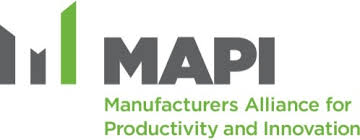
As the chill starts to settle into the Northeast, signaling that autumn has arrived, many people are breaking out the sweaters and bracing for colder weather. I, however, recently had the opportunity to raise the temperature a few degrees by attending the MAPI Marketing Council Meeting in Atlanta, where temperatures still hover in the low 80s. At the meeting, I presented the findings of a collaborative research study between Zift Solutions and MAPI, and later led a best practices workshop session on channel marketing. Many of the marketing leaders in attendance were from leading manufacturers, such as Schneider Electric, Eaton Corporation and Rockwell Automation. I also had the privilege of personally connecting with the MAPI team, which ran a very focused, professional event was loaded with valuable content for its members.
As I shared some of the findings from the research study, which offered insights into the state of supplier-partner marketing in the manufacturing vertical, I was reminded of my past experiences in building a channel program for a software company that provided a manufacturing ERP solution in the late 1990s. What’s remarkable to me today is that not much has changed when it comes to marketing tactics in supplier-partner marketing over the past 15 years.
Clearly, the marketing environment has changed, including a dramatically different buyer who is accustomed to self-serving content from partner and supplier websites. But the tools and assets employed by channel marketers — such as mailers, direct advertising and brochures used to reach dealers and their customers — haven’t changed much at all. Granted, manufacturing channels are different than, say, high tech or financial services channels. For example, they encompass both B2B and B2B2C. And manufacturing companies can span many vertical industries, ranging from health care to food service to retail.

However, the Zift/MAPI study revealed that many of the manufacturers surveyed have not yet fully embraced digital marketing with partners, and those that have, take the “spray and pray” approach. In fact, during one memorable moment, a workshop participant admitted that, “many of us do well at trying everything, but few do anything particularly well.” Through sheer stick-to-itiveness, the group did walk away with two valuable insights: Better performance requires better alignment to both the partner and the target buyer.
Alignment to the Partner
Many workshop attendees admitted that they rarely align to different types of partners, such as dealers or sales agents, when developing digital marketing campaigns. Whether the partner employs an inside sales team that could pre-qualify leads or they sell through e-commerce, where trials could work better, the sales approach used was rarely factored into partner marketing campaigns. Many MAPI participants admitted they take a one-size-fits-all approach, delivering the same assets and campaigns to dealers, whether they are exclusive or non-exclusive. Furthermore, as manufacturers adopt IoT (internet of things) solutions, few reported adapting their messaging to address this type of paradigm change or employing tactics, like social media, to drive thought leadership with early-stage buyers.
There were also a lot of comments from MAPI participants who struggle with partner adoption. One “aha” moment came when the discussion focused on the partner’s perspective and understanding the marketing journey they take with suppliers. From a partner point of view, it became clear that suppliers in the room needed to invest more in “marketing-to” partners in order to raise adoption and engagement, given the limited results many were obtaining from their channel marketing efforts. Simply thinking about what’s in it for the partner, as they make them offers to engage in joint marketing programs, is one way some of the companies will begin to change their conversation to gain greater alignment.
Alignment to the Target Buyer
It’s always fascinating to see how products are made and how they are used in an industry. As we discussed the different types of content — such as video, social media, printed materials, etc. — that suppliers create for their channel partners, and ultimately for the customer, it was apparent that our group needed to develop a framework for aligning their content to their buyer’s purchasing journey. The idea that different content — such as white papers — can be more effective in the middle of the journey as buyers are narrowing down their choices, rather than in the beginning where a case study might work better, was new to most of the group. This wasn’t the only point and, more importantly, it isn’t the issue that makes marketing in the manufacturing vertical different.
One member said it best when he described how his company, which develops conveyor systems for the coal industry, sells to one particular buyer, while another buyer, the head of logistics for a large distributor like Amazon.com, has a totally different set of needs. In each case, the supplier has to identify the individual personas in each industry in order to create different sets of content to effectively market to them. Adapting to different buyer types, and not just roles, adds a whole new dimension to marketing directly to and through channel partners.
Marketing Opportunities to Draw From
There’s no doubt that marketers in manufacturing companies have their work cut out for them, especially those trying to create demand and share leads with partners. However, it isn’t all bad news. This is a great opportunity to borrow from other industries (like high tech) that have advanced channel marketing to the point where new tools and automation are already in use to drive efficiency and measurable results.
There is also an opportunity to learn from the mistakes of others: Suppliers in other industries may have found ways to gain better alignment by not taking a one-size-fits-all approach. These lessons learned clear the path for modern marketers in manufacturing, where taking a new approach — as I learned at the MAPI Council — is well received. I welcome the chance to share some of the channel marketing best practices that Zift has learned from working with several manufacturing companies to drive higher productivity in their joint marketing efforts and lead-generating programs.
You can reach Laz at lazgonzalez@ziftsolutions.com or follow @lazgonzalez on Twitter.
Laz Gonzalez
Laz Gonzalez is Chief Strategy Officer at Zift Solutions. A prominent industry analyst and thought leader, Gonzalez brings unparalleled channel expertise to Zift and has served as strategic adviser to leading B2B channel programs worldwide.




